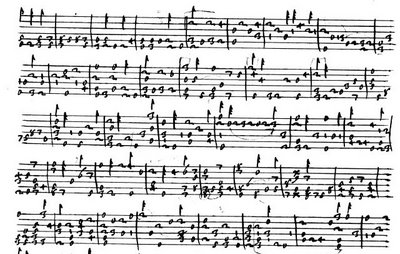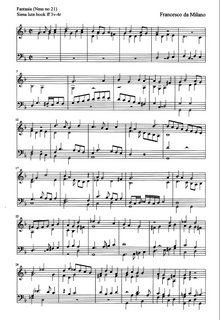
Thinking further about Hopkinson Smith's comment about polyphony on the lute (see my last post). Here's the start of a piece by Francesco da Milano, his Recercar no 21 from the Siena lute book, which I'm playing in a concert later this month. Embedded in this tablature is an intricate 4-voice polyphonic composition, packed full of tight imitative counterpoint. HS is absolutely right: the flexibility of the lute does make it possible to bring out voices and entries, and therefore the structure of the piece, more than on the organ.
 Here's a transcription showing it in staff notation (as ever, click on the image to enlarge). Now the musical content appears, but the fingering is lost. To study a piece like this seriously, I like to have both versions available and to treat them as complementary to one another. But I always play from the tablature, and preferably from a facsimile of the original, even when it's as squiggly as this.
Here's a transcription showing it in staff notation (as ever, click on the image to enlarge). Now the musical content appears, but the fingering is lost. To study a piece like this seriously, I like to have both versions available and to treat them as complementary to one another. But I always play from the tablature, and preferably from a facsimile of the original, even when it's as squiggly as this.The Siena lute book has been dated to c. 1560-70, a good 20 years after Francesco's death in 1543, which shows the lasting power of his music. This recercar also appears in the Casteliono lute book of 1536. There are some nice extra touches in the Siena version, such as the twiddly bit in bar 20 and the B flat / B natural opposition in bars 24-5 (Casteliono has B flat throughout - safer but less piquant). Many years later, the recercar turns up again in Besard's collection Thesaurus Harmonicus, published in Cologne in 1603, and attributed this time to Edinthon Galli (who he?).

This strange creature is the watermark from the Siena book. If you want to buy the facsimile, you'll find it at Minkoff Editions for the eyewatering price of €114.

No comments:
Post a Comment